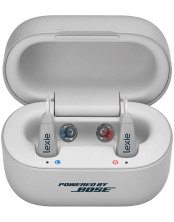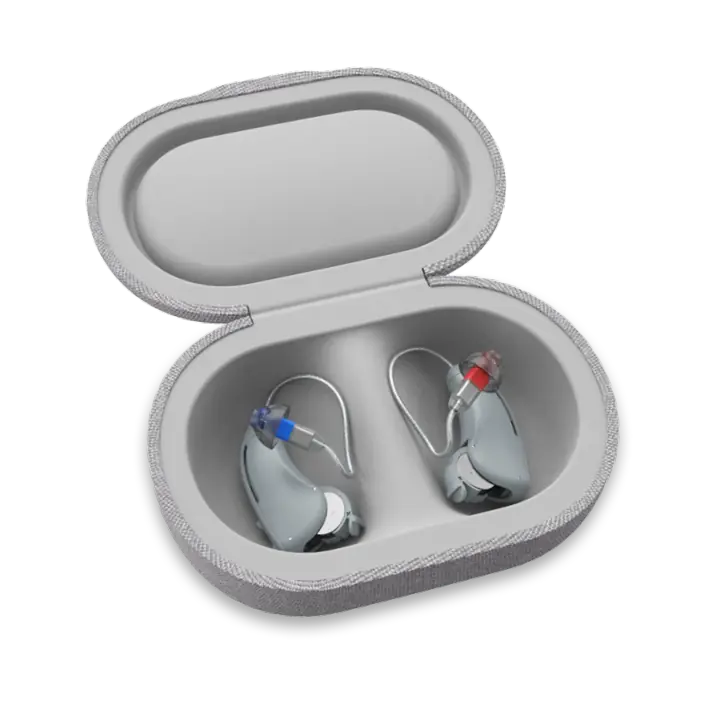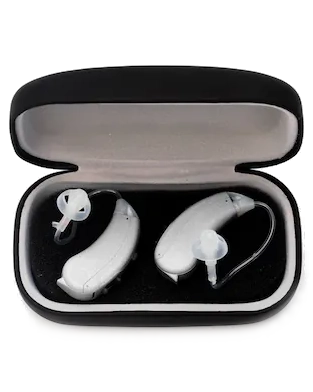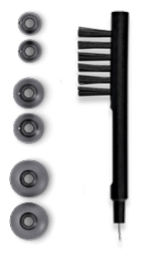How Personal Sound Amplification Products Differ From Hearing Aids
Published: July 5, 2022
Do you ever have trouble hearing your friends and family during conversations? You’re not alone. Millions of people experience some form of hearing loss. Many of these individuals use hearing aids to treat their hearing loss—however, you may come across a different line of hearing amplification devices: personal sound amplification products (PSAPs).
But what’s the difference between these two types of devices? And which one is right for you? Keep reading to learn more.
What are Personal Sound Amplification Products?
PSAPs are hearing amplification devices designed for individuals with normal hearing. PSAPs can be purchased over-the-counter at an average price of about $300. Like hearing aids, PSAPs feature a microphone and a receiver that work to enhance external sounds.
Because they’re designed for individuals with normal hearing, they’re commonly used in specific situations that may require a heightened hearing sense, such as hunting or bird watching.
While advancements in technology have led to PSAPs improving in both quality and performance, they are not designed as medical devices. In fact, the FDA prohibits PSAPs from being marketed as such—instead, they are considered recreational, wearable electronic products.
How do Personal Sound Amplification Products Differ From Hearing Aids?
Despite their functional similarities, PSAPs and hearing aids feature a number of important differences.
Purpose and Classification
The most important distinction between the devices is that hearing aids are designed specifically to treat hearing loss, while PSAPs are not. Hearing aids are considered medical devices and are therefore regulated by the FDA. As mentioned above, PSAPs are not medical devices and are not regulated by the FDA.
Sound Customization
One of the key functional differences between PSAPs and hearing aids is how the devices amplify sound. Because hearing aids are designed to treat hearing loss, they can be programmed to amplify or reduce specific sounds depending on the user’s needs and situation.
For example, many hearing aids come equipped with background noise reduction technology that improves performance in louder environments, such as a restaurant. On the other hand, PSAPs don’t feature this level of customization—they simply amplify all sounds in the environment. This means that a user wearing a PSAP will likely still have trouble hearing in a loud environment because all background noise is being amplified.
Price
Another major difference between PSAPs and hearing aids is cost. Traditional hearing aids often cost thousands of dollars. Direct-to-consumer hearing aids—and the incoming over-the-counter hearing aids—have drastically reduced the cost of hearing aids, with some brands offering pairs of hearing aids for under $1,000.
However, even the lower costs of direct-to-consumer hearing aids are still generally higher than the cost of PSAPs. While some high-end PSAPs are available, these devices typically cost between $200 and $400.
Can Personal Sound Amplification Products Treat Hearing Loss?
PSAPs are not designed for individuals with hearing loss, and therefore, they aren’t regulated as medical devices intended to treat hearing loss. However, given their lower price tag and availability on store shelves, some may choose to purchase these devices in place of hearing aids. But should they?
In general, PSAPs aren’t recommended as a treatment for hearing loss. These devices lack the professional, medical-grade features of hearing aids and can’t provide the same benefits to individuals with hearing loss.
That being said, some audiologists agree that using PSAPs can be better than nothing—specifically for cases of mild hearing loss. If the financial burden of a hearing aid is too much, PSAPs can be a cost-effective alternative that, while not providing the same level of treatment, can still make it easier to hear sounds that otherwise may be missed—and make it easier to converse with others. Social isolation due to hearing loss can have serious impacts on overall health and well-being, and PSAPs can be helpful for encouraging interaction with others.
Still, if hearing loss is suspected, it’s important to complete a hearing test to assess the level of hearing loss present. Visiting with an audiologist for a full hearing evaluation can provide clarity on whether hearing aids are recommended, or if alternative treatment methods may suffice. Some hearing care providers also offer free online hearing tests that can be done right from home and provide results in minutes.
Getting Treatment for Hearing Loss
While PSAPs can provide amplified sound similar to hearing aids, they aren’t designed to treat hearing loss. Their low price points may be appealing, but investing in hearing aids can be worth the difference in order to get proper, quality hearing loss treatment.
Additionally, direct-to-consumer hearing aids have bridged the gap between individuals and professional hearing care by making devices available for a fraction of the cost of traditional hearing aids. While they still cost a bit more than PSAPs, the difference is in the hundreds of dollars rather than the thousands.
For example, Lexie hearing aids come equipped with advanced features like directional microphones, background noise reduction, and clear sound. There’s no need to visit an audiologist, as autofit technology make these hearing aids ready to go right out of the box, meaning professional hearing treatment is only a few clicks away.
If you have hearing loss and are looking for a cost-effective but powerful solution, try the Lexie hearing aids risk-free today. Shop online or contact a Lexie Expert for more information.






